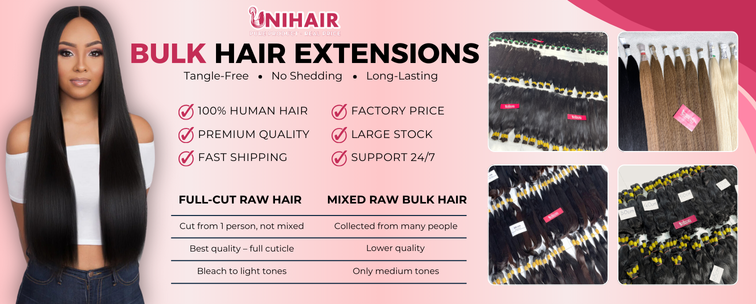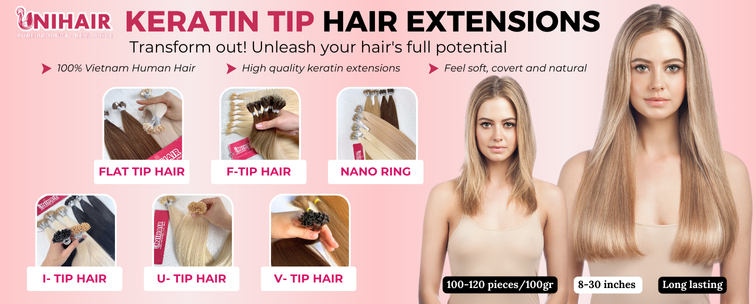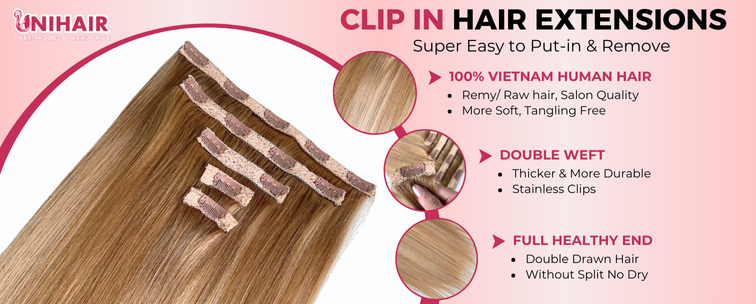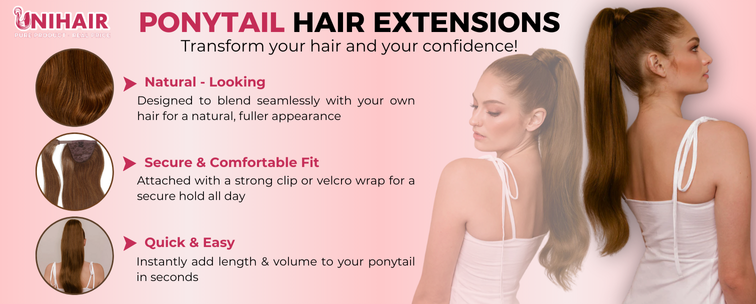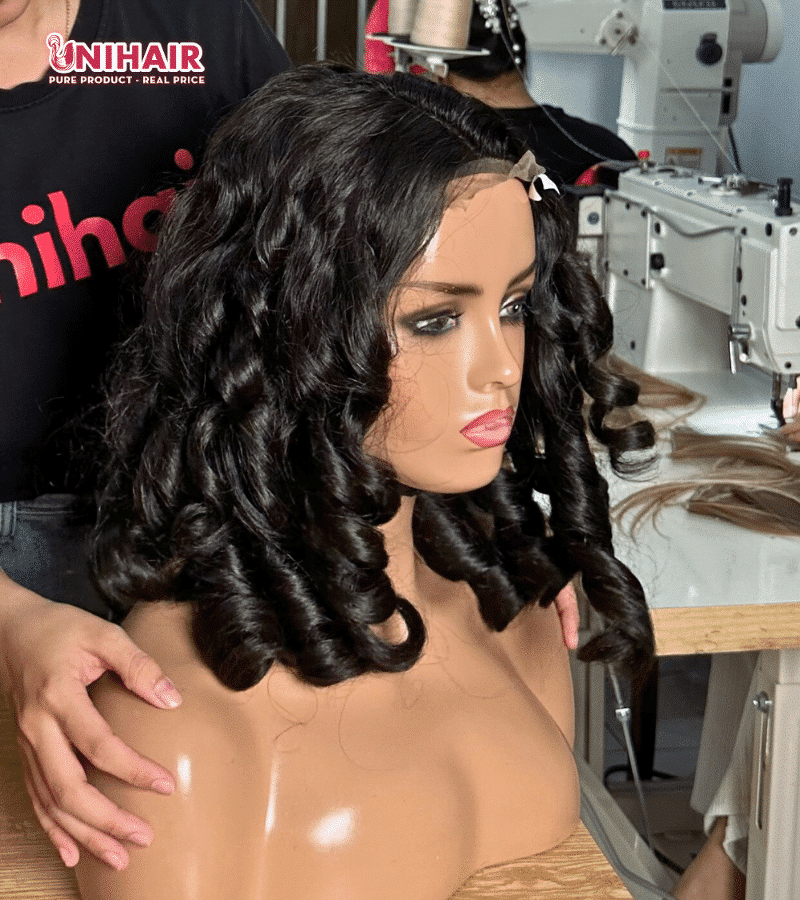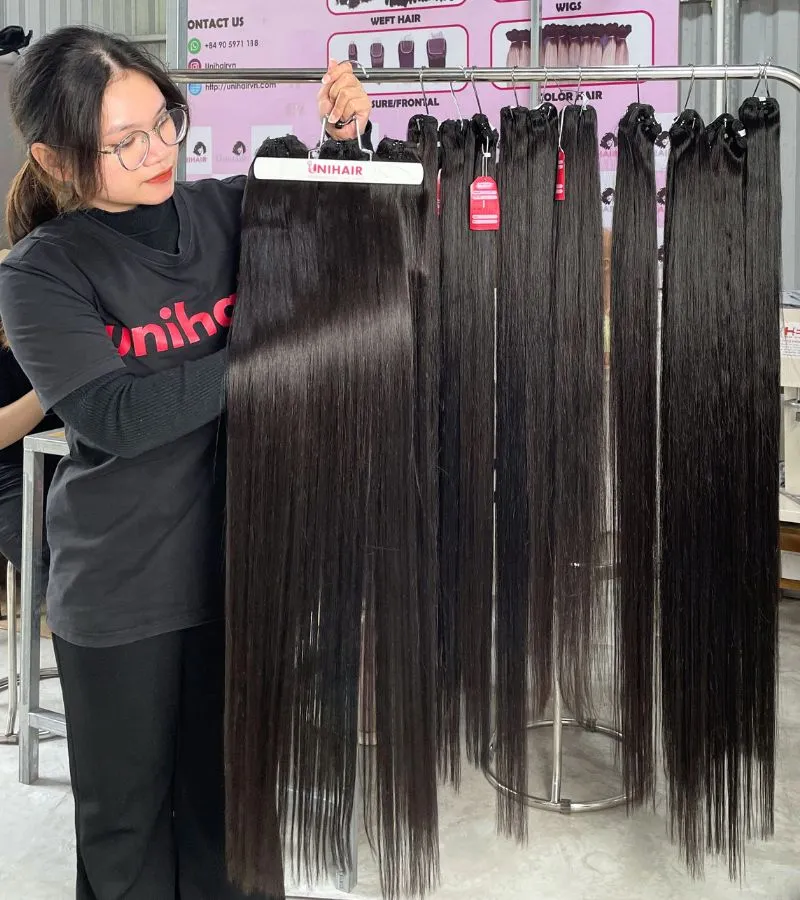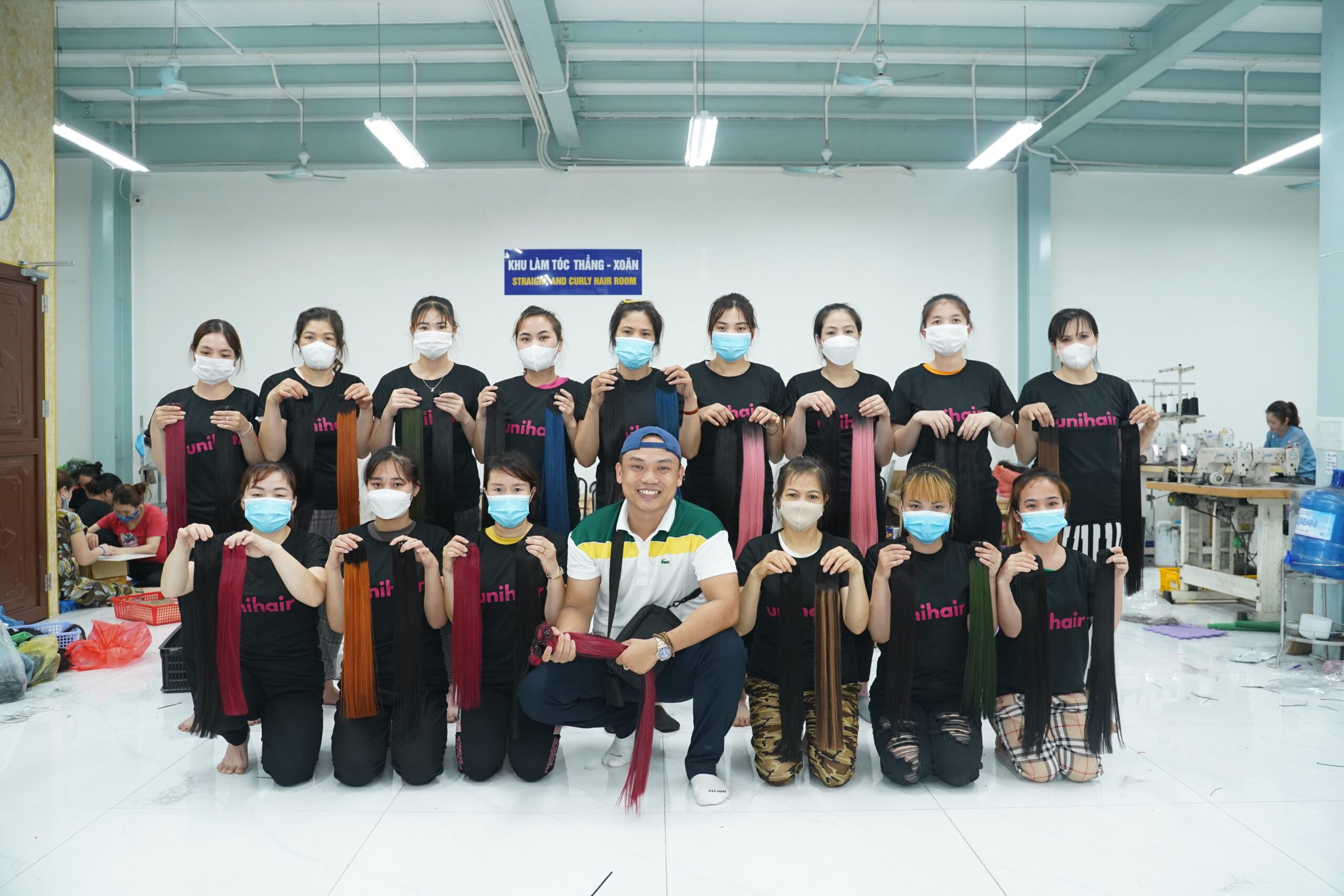Advantages And Disadvantages of Human Hair Wigs: What to Expect
Human hair wigs are a top choice for those who want a natural, realistic look with the flexibility to style, dye, and treat the wig like real hair. However, before making an investment, it’s important to consider both sides: What are the advantages and disadvantages of human hair wigs? While they offer great customization and long-term use, they also come with downsides like higher cost, more maintenance, and sensitivity to weather. In this article, we’ll compare human hair wigs with synthetic options to help you decide which one best suits your needs.
Comparison Human Hair Wigs vs. Synthetic Wigs

Appearance and Realism
- Human Hair Wigs:
Human hair wigs offer the most natural look and feel, closely resembling real hair. They have natural movement, texture, and shine, making them virtually indistinguishable from your own hair in spite of disadvantages of human hair wigs. You can also customize them with dyeing, cutting, and styling, just like natural hair. - Synthetic Wigs:
Synthetic wigs are made from artificial fibers that are designed to mimic the look of natural hair. While they can look realistic from a distance, they often lack the natural movement and shine of human hair wigs. Some newer synthetic wigs are made with high-quality fibers that mimic natural hair more closely, but they still don’t quite match the authenticity of human hair.
Durability and Longevity
- Human Hair Wigs:
Human hair wigs are durable and can last a long time when properly cared for—often several months or even years. Their longevity depends on how well they are maintained, including regular washing, conditioning, and proper storage. They are more resilient to heat styling and can be restyled multiple times. - Synthetic Wigs:
Disadvantages of synthetic hair wigs are shorter lifespan, typically lasting between 6 months to a year, depending on wear and care. Synthetic fibers are more prone to damage from heat and sunlight, and they cannot be restyled or dyed like human hair wigs. Over time, synthetic wigs may lose their luster or become frizzy, reducing their lifespan.
Styling and Customization
- Human Hair Wigs:
One of the biggest advantages of human hair wigs is their versatility. You can style them with heat tools (curling irons, straighteners, etc.), cut them, or color them. This allows for total customization, making it easy to achieve your desired look and even change styles over time. - Synthetic Wigs:
Synthetic wigs are pre-styled and are designed to maintain their shape even after washing. However, they cannot be styled with heat tools because the fibers will be damaged. Most synthetic wigs are locked into a specific style, and altering their shape may not be possible. Some high-end synthetic wigs offer a limited amount of styling options, but their flexibility is much more restricted than human hair wigs.
Maintenance and Care
- Human Hair Wigs:
Human hair wigs require regular maintenance to keep them in good condition. This can be considered disadvantages of human hair wigs since it includes washing, conditioning, and detangling, much like natural hair. The wig may need to be restyled or trimmed by a professional from time to time. While they need more care than synthetic wigs, they can also last longer if properly maintained. - Synthetic Wigs:
Synthetic wigs are generally easier to maintain since they don’t require styling or as much upkeep. They hold their shape after washing, so you don’t need to restyle them. However, they need to be washed with gentle care and cannot be subjected to hot water or harsh chemicals, which could ruin the fibers.
Cost
- Human Hair Wigs:
Human hair wigs are more expensive than synthetic wigs due to the cost of the natural hair, as well as the labor required for their production. Expect to pay significantly more for a high-quality human hair wig. However, this investment is often justified by the durability, natural look, and styling flexibility they offer despite disadvantages of human hair wigs. - Synthetic Wigs:
Synthetic wigs are more affordable than human hair wigs. They are an excellent option for those on a budget or those who only need a wig for short-term use or special occasions. While they may not offer the same realism or longevity as human hair wigs, they provide a good balance of cost and convenience.
Advantages Of Human Hair Wigs

Authentic Movement and Texture
Human hair wigs behave exactly like real hair, meaning they flow naturally as you move. The individual strands are flexible, giving the wig a life-like movement that synthetic wigs cannot match.
The softness of human hair wigs closely mimics that of healthy natural hair, providing a smoother feel and appearance. They also retain moisture better, making them look healthier over time.
Seamless Blending with Natural Hair
A high-quality human hair wig can blend seamlessly with your natural hair, whether it’s worn short, long, or in specific textures. Lace front wigs, in particular, allow the wig to blend naturally at the hairline, making it indistinguishable from your own hair.
If you’re transitioning from hair loss, a human hair wig can be styled to match your existing hair’s length, color, and texture, allowing for a smooth transition without needing to cut or alter your natural hair.
Longer-Lasting Shape and Style
The benefits of human hair wigs are holding their shape well. For example, curly human hair wigs can retain their curl pattern for an extended period, even after washing or styling, unlike synthetic curls that may lose their shape quickly.
When properly maintained, human hair wigs rarely suffer from frizz, providing you with a consistently smooth and sleek appearance.
Long-Term Cost-Effectiveness
While the initial cost of a human hair wig is higher, their longevity and ability to withstand styling and washing over time make them more cost-effective in the long run. With proper care, a human hair wig can last anywhere from several months to a few years, unlike synthetic wigs that require replacement more frequently.
Human hair wigs withstand wear and tear better than synthetic wigs, which can degrade from heat styling or exposure to UV rays. Human hair wigs maintain their integrity longer and will still look great after repeated use.
Ability to Handle High Heat
Unlike synthetic wigs, which can melt or lose shape when exposed to heat, human hair wigs can safely be styled with hot tools such as straighteners, curling irons, and blow dryers, just like natural hair. This allows for a higher degree of versatility in styling.
You can create any look you want, from sleek straight styles to voluminous curls, with the flexibility of using hot tools without damaging the wig.
Disadvantages Of Human Hair Wigs
While human hair wigs offer numerous benefits, they also come with certain disadvantages of human hair wigs that potential users should consider before making a purchase. What are the disadvantages of human hair wigs? Are disadvantages of human hair wigs so serious? Let’s find out!

Higher Cost
One of the most significant disadvantages of human hair wigs is their high cost. This price reflects the quality of the material and the effort involved in manufacturing, but it can be a barrier for some individuals looking for a more affordable solution.
Additionally, since human hair wigs require regular maintenance, there are continuous costs involved. This includes purchasing specialized hair care products and paying for professional styling or repairs when necessary, which can add up over time.
Maintenance and Care
Disadvantages of human hair wigs lie in the fact that human hair wigs need regular washing, conditioning, and detangling. They require the same care as natural hair to ensure they remain in good condition, which can be time-consuming and cumbersome for those with busy schedules.
Even though human hair wigs are durable, they are still susceptible to damage from heat styling, environmental factors, or rough handling. Over time, if not cared for properly, they can lose their shine, texture, or shape, which is a major downside for people seeking a low-maintenance hair option.
Vulnerability to Environmental Factors
The disadvantages of human hair wigs include their vulnerability to the elements. Just like natural hair, they can be affected by humidity, rain, or harsh weather conditions. In humid climates, human hair wigs can become frizzy, while in dry weather, they may become brittle and lack moisture.
Because human hair wigs react to environmental changes, they may require restyling throughout the day, especially in extreme temperatures. This makes them less convenient compared to synthetic wigs, which tend to hold their style more consistently.
Weight and Bulk
What are the disadvantages of wearing a wig? Human hair wigs are generally heavy. This added weight can cause discomfort, especially if the wig is large or made from thick hair. For people who wear wigs daily, the weight can lead to scalp strain or headaches after extended wear.
Due to the density of human hair, these wigs can sometimes feel bulky, making them disadvantages of human hair wigs, less ideal for those who prefer lightweight, minimalistic options.
Prone to Tangling
Another one disadvantages of human hair wigs is that they are prone to tangling, especially if they are long or not regularly maintained. Tangling can be a problem for those who wear wigs frequently, and the process of detangling can cause the hair to break if not done gently and correctly.
This tangling issue can require more frequent attention and maintenance, as the wig needs to be detangled, conditioned, and styled regularly to maintain a smooth, natural look. To some hair-lovers, this is seen as one of the disadvantages of human hair wigs.
Limited Water Resistance
Human hair wigs are not as water-resistant. Excessive exposure to water can cause them to lose their shape or become limp. If you’re someone who enjoys outdoor activities or is in the rain often, you may find this to be a disadvantage.
Human hair wigs are also not suitable for swimming in chlorinated or salty water, as this can cause significant damage to the hair fibers, making them dry, brittle, or prone to tangling.
Understanding the disadvantages of human hair wigs can help you make an informed decision about whether they are the right choice for your needs. While they offer numerous pros and cons of human hair wigs like a natural look and styling flexibility, the cost, maintenance, and environmental sensitivity are factors to consider when choosing between human hair wigs and other hair alternatives.
Aftercare Tips for Dyed Human Hair Wigs
Even though dyed human hair wigs offer a natural and versatile look, they require proper care to maintain their quality and color. Here are some aftercare tips to keep your dyed human hair wig looking its best. It’s important to note that the extra maintenance required is one of the disadvantages of human hair wigs, as they demand more attention compared to synthetic alternatives.
Use Color-Safe Shampoo
To prevent fading, use a color-safe shampoo specifically designed for dyed hair. These shampoos help protect the vibrancy of the color while gently cleansing the hair. Regular shampoos can strip the dye and leave the wig looking dull. A color-safe shampoo maintains the wig’s shade without causing dryness or disadvantages of human hair wigs, a common challenge faced by those who wear dyed human hair wigs.
Deep Condition Weekly
One of the disadvantages of human hair wigs is that they can become dry, especially after dyeing. To keep the wig moisturized and shiny, deep condition it at least once a week. Choose a deep conditioner that hydrates and nourishes, focusing on the ends where dryness and damage can occur. This helps to prolong the life of the wig and keep the hair feeling soft.
Limit Heat Styling
Excessive heat can damage dyed human hair wigs, leading to color fading and dryness. Limit the use of heat tools like flat irons, curling irons, and blow dryers to protect the hair’s texture and prevent further damage. When you do use heat, apply a heat protectant spray to create a barrier against high temperatures. The need to minimize heat usage is another disadvantage of human hair wigs, as it can limit styling options.
Dry with Care
When drying a dyed human hair wig, avoid rough handling. Instead, gently pat the hair with a soft towel to remove excess moisture. Let it air dry whenever possible to preserve the integrity of the hair and color. Using a hair dryer can lead to dryness and color degradation, which are common issues linked to the disadvantages of human hair wigs.
Protect from Environmental Factors
Environmental factors like sunlight, pollution, and humidity can affect dyed human hair wigs. Direct sun exposure can cause color fading, while pollution can make the hair look dull. To protect your wig, consider wearing a hat or scarf when you’re outside for extended periods. Applying a leave-in conditioner with UV protection can also help shield the wig from environmental damage, though this adds to the time and care commitment—highlighting another disadvantage of human hair wigs compared to synthetic options.
By following these aftercare tips, you can maintain the color, shine, and overall quality of your dyed human hair wig, despite the extra effort involved.

Disadvantages Of Human Hair Wigs (FAQS)
Are Human Hair Wigs Worth It?
Are human hair wigs good? Yes, human hair wigs are often considered worth the investment for those seeking a high-quality, natural-looking alternative to synthetic wigs. Although they come with some disadvantages of human hair wigs, such as higher costs and greater maintenance needs, the benefits they offer can outweigh these drawbacks for many. Human hair wigs look incredibly realistic, can be heat-styled, and are customizable with cuts and colors. They also tend to be more durable, lasting much longer than synthetic wigs when properly cared for.
Are Wigs Bad For Your Hair?
Wearing wigs, including human hair wigs, is not inherently bad for your hair if you follow proper care guidelines. However, some disadvantages of human hair wigs can arise if they are not worn or maintained correctly. To protect your natural hair and scalp, it’s crucial to ensure the wig is well-fitted and not too tight, allowing your scalp to breathe. Maintaining good scalp hygiene and regularly moisturizing your hair underneath the wig can prevent potential damage, such as breakage or dryness.
How Do I Prevent My Human Hair Wig From Getting Damaged?
To prevent damage, avoid excessive heat styling, protect the wig from direct sun exposure, and always use proper hair care products like color-safe shampoo and deep conditioners. Additionally, minimize washing and styling to reduce wear and tear on the wig. It’s also crucial to store the wig properly when not in use to maintain its shape and quality.
Are Human Hair Wigs Suitable For People With Sensitive Scalps?
Human hair wigs are generally more breathable and comfortable than synthetic wigs, making them a good option for people with sensitive scalps. However, it’s essential to choose wigs with gentle, non-irritating materials, such as lace fronts or soft caps, to avoid discomfort.
What Makes Human Hair Wigs More Natural-Looking Than Synthetic Wigs?
Apart from the disadvantages of human hair wigs, these wigs are more natural-looking because they replicate the texture, movement, and shine of real hair. They can be styled with heat tools, dyed, and customized to suit individual preferences, offering a more realistic appearance compared to synthetic wigs, which may lack flexibility and the ability to mimic natural hair.
Do Human Hair Wigs Require More Time And Effort To Maintain?
Yes, one of the key disadvantages of human hair wigs is the time and effort required to maintain them. They need regular washing, conditioning, styling, and protection from heat and environmental damage. This maintenance can be more intensive compared to synthetic wigs, which are lower maintenance but may not offer the same look and longevity.
Can I Sleep With My Human Hair Wig On?
It’s not recommended to sleep with your human hair wig on, as it can cause tangling, breakage, and unnecessary stress on the hair fibers. To protect your wig, it’s best to remove it at night. If you must wear it overnight, tie it loosely in a silk or satin scarf to reduce friction and prevent damage and disadvantages of human hair wigs.

Conclusion
While human hair wigs offer unmatched realism, versatility, and style, it’s essential to weigh the disadvantages of human hair wigs before making a decision. These wigs require more maintenance, come at a higher price point, and need careful handling to preserve their quality and appearance. They are also sensitive to environmental factors and may require additional products to maintain their look. Understanding the pros and cons can help you decide if the investment and upkeep are right for you. By being aware of the disadvantages of human hair wigs, you can make an informed choice that aligns with your lifestyle, budget, and personal preferences.


